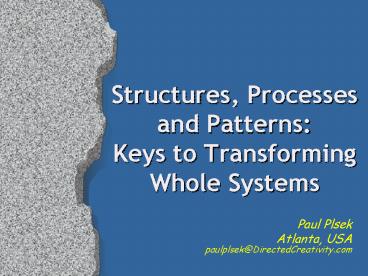Structures, Processes and Patterns: Keys to Transforming Whole Systems - PowerPoint PPT Presentation
1 / 19
Title:
Structures, Processes and Patterns: Keys to Transforming Whole Systems
Description:
Formulae have only a limited application. Raising one child gives no ... issue, or is change bogged down in a treacle of hierarchy and position-authority? ... – PowerPoint PPT presentation
Number of Views:96
Avg rating:3.0/5.0
Title: Structures, Processes and Patterns: Keys to Transforming Whole Systems
1
Structures, Processesand PatternsKeys to
Transforming Whole Systems
- Paul Plsek
- Atlanta, USApaulplsek_at_DirectedCreativity.com
2
Why do organisational transformation efforts tend
to fall short of expectations?
3
Complex
Complicated
Simple
Source Brenda Zimmerman, PhD
4
Systems can be described by...
- Structures (concrete attributes)
- Processes (sequence of events)
- Patterns (phenomena, behaviours)
Source Fritjof Capra
5
Respiratory System
- Structure Process Pattern
- Nose Respiration Emphysema
- Trachea Respiration
- Bronchus - resting
- Lungs - exertion
- Etc. Etc.
6
Medication Administration System
- Structure Process Pattern
- Pharmacy Ordering Prescribing practices
- Nursing units Transcribing Types of errors
- Elevators Entering Feelings values
- Committees Dispensing Supportive behavior
- Info systems Etc. Blaming
- Individual roles Fear
- Etc. of errors reported
- Etc.
7
Reflections on Large-Systems Change Efforts in
NHS-England
Results/Change
WeakCounter?
StrongerToo slow?
Uncertain?Potentially powerful
Regulatesspeed?
Structure Process Pattern
Culture
Dialogueabout
Expose
SimpleRules
LearningLoop
Suggesta wayforward
Learn
Leadership
Do something
Source Nigel Edwards, Phil Hadridge, Paul Plsek
8
Reflections on Large-Systems Change Efforts in
NHS-England
Results/Change
Source Nigel Edwards, Phil Hadridge, Paul Plsek
9
Reflections on Large-Systems Change Efforts in
NHS-England
Results/Change
WeakCounter?
StrongerToo slow?
Structure Process
Source Nigel Edwards, Phil Hadridge, Paul Plsek
10
Reflections on Large-Systems Change Efforts in
NHS-England
Results/Change
WeakCounter?
StrongerToo slow?
Uncertain?Potentially powerful
Regulatesspeed?
Structure Process Pattern
Culture
Dialogueabout
Expose
SimpleRules
LearningLoop
Suggesta wayforward
Learn
Leadership
Do something
Source Nigel Edwards, Phil Hadridge, Paul Plsek
11
Organisational Change Efforts
- Much change in structure
- Classic improvement work focusses on process
- Patterns are more difficult and are often left
largely untouched - Successful large-scale transformation requires
integration and change in structure, process, and
pattern
12
Examples of Structures
- Policies, regulations, terms of references, etc.
- Charts of organisation, roles, etc.
- Committees, teams, forums, working groups,
communities of practice, etc. - Physical space, equipment, etc.
13
Examples of Processes
- Guidelines, procedures, protocols
- Any flow of people, information, supplies, etc.
that can be captured on a process map
14
Five Key Aspects ofOrganisational Culture
- Key aspects that need rethinking in health care
organisations include - the nature of relationships
- how decisions are made
- how power is defined, acquired, and used
- how conflict is handled
- how learning is supported
15
Key Patterns in Organisations
- Relationships
- Decision-making
- Conflict
- Power
- Learning
16
Key PatternRelationships
Do the interactions among the various parts of
the system generate energy and innovative ideas
for change, or do they drain the organisation?
17
Key PatternDecision-Making
Are decisions about change made rapidly and by
the people with the most knowledge of the issue,
or is change bogged down in a treacle of
hierarchy and position-authority?
18
Key Pattern Power
Do individuals and groups acquire and exercise
power in positive, constructive ways toward a
collective purpose, or is power coveted and used
mainly for self-interest and self-preservation?
19
Key Pattern Conflict
Are conflicts and differences of opinion embraced
as opportunities to discover new ways of working,
or are these seen as negative and destructive?
20
Key Pattern Learning
Is the system naturally curious and eager to
learn more about itself and about what might be
better, or is new thinking viewed mainly as
potentially risky and threatening to the status
quo?
21
Five Key Aspects ofOrganisational Culture
- Key aspects that need rethinking in health care
organisations include - the nature of relationships
- how decisions are made
- how power is defined, acquired, and used
- how conflict is handled
- how learning is supported
22
Patterns to Support Improvement
- Spread and share learning, continuous learning
- Constructive conflict
- Support for risk taking, learning from mistake
- Decision making, devolved to front line, until it
scares you - Letting go of power
- Respecting diversity
- Being benefits focussed
- Taking an appreciative inquiry approach
- Being focussed, prioritising, clear goals
- Having consistency of behaviours
- Helping people to learn and unlearn, supporting
development - Behaving with honesty, trust, open, etc.
- Walking the talk, leading by example
- Understanding each others roles and issues
- Giving time and space for learning
- Everything is aimed at improving every patients
experience - We all commit to the above and will challenge
each other on it
23
Key Questions for Today
- What structures, processes, and patterns (SPP) do
we need in order to raise our game for
improvement in West Yorkshire? - What SPP already exist? What SPP do we need to
change?What SPP do we need to create?
24
Key Questions for Today
- What structures, processes, and patterns (SPP) do
we need in order to achieve our objectives? - What SPP already exist? What SPP do we need to
change?What SPP do we need to create?































